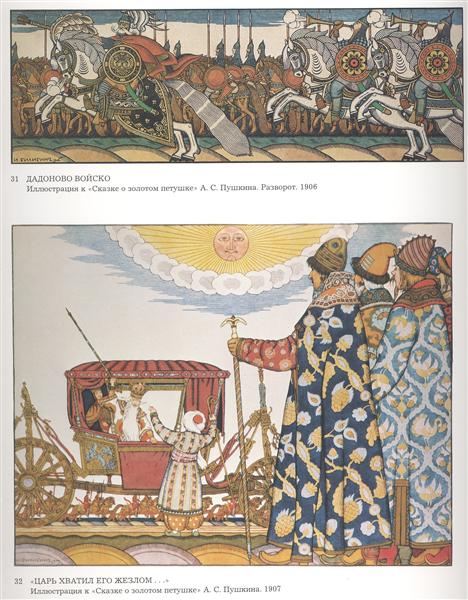Description
The world of Russian art of the early twentieth century has read us a plethora of works that not only capture the essence of their time, but also evoke the rich cultural and literary tradition of the region. Among these treasures, the "Illustration for the poem 'The story of the Golden Gallo' by Alexander Pushkin" of 1906, created by the remarkable illustrator Ivan Bilibin, stands out for its ability to combine visual narrative with an intricate exploration of Russian folklore.
Ivan Bilibin, recognized for his skill in the illustration of popular stories and Russian literature, plasma in this work a perfect balance between the narrative and the ornamental. The work in question is a representation for the famous poem by Alexander Pushkin, whose title flirts with fantasy and intrigue: "The story of the golden rooster." This poem, a fable rich in symbolism and morality, finds in Bilibin a visual translator that manages to maintain its magical essence and its literary dynamism.
When observing the paint, one is immediately arrobated by the masterful use of color and composition. The image is dominated by warm and golden tones, which refer to the golden rooster of the title, a central symbol in the narrative. This rooster, perched with almost royal elegance on a high structure that looks like an ornamental clock or an artifact with a guardian function, imposes its presence with an almost ethereal shine. Its vigilant posture and glowing plumage combine to transmit a sensation of magical surveillance.
In the scene, we can identify three clearly delineated characters, immersed in an environment that evokes both opulence and nature. On the left, a soldier with armor and helmet seems to be watching the rooster with a mixture of reverence and surprise. In the center of painting, An old man with a long beard, possibly a wise or wizard, raises a hand as if he were indicating or conjuring the power of the golden rooster. This character can be interpreted as a figure of authority or knowledge, a guide in Pushkin's narrative.
On the right, a third character, a medium -sized man and real appearance, with a crown and rich clothing, whose profile conveys a sense of concern or intrigue, completing the trinity of human figures. The interaction between these characters and their natural environment, full of floral and architectural details, reflects the bilibin ability to mix the mundane with the fantastic.
Bilibin's decorative style is presented in elements such as detailed architectures and intricate patterns that adorn the scene, evoking illuminated manuscripts and traditional Russian ceramics. These details are not merely ornamental; They provide an additional layer of meaning and connect the work with a collective cultural past.
It is remarkable how bilibin uses clear and defined lines to delineate not only the characters, but also to the structural components of the landscape, which give a feeling of an orderly world and content. Each design seems almost geometric, reaffirming the influence of Russian-Bizantine aesthetics and the artist's love for clear forms and symmetrical compositions.
Ultimately, "Illustration for the poem 'The story of the golden rooster' by Alexander Pushkin" by Ivan Bilibin is a masterpiece that encapsulates the perfect synthesis of visual art and literary narrative. It offers us a specific period of the history of Russian art, where the popular story and high literature converge through the talent of an illustrator who deeply understood both the texts he illustrated and the artistic techniques he used to give him life.
KUADROS ©, a famous paint on your wall.
Hand-made oil painting reproductions, with the quality of professional artists and the distinctive seal of KUADROS ©.
Art reproduction service with satisfaction guarantee. If you are not completely satisfied with the replica of your painting, we refund your money 100%.

